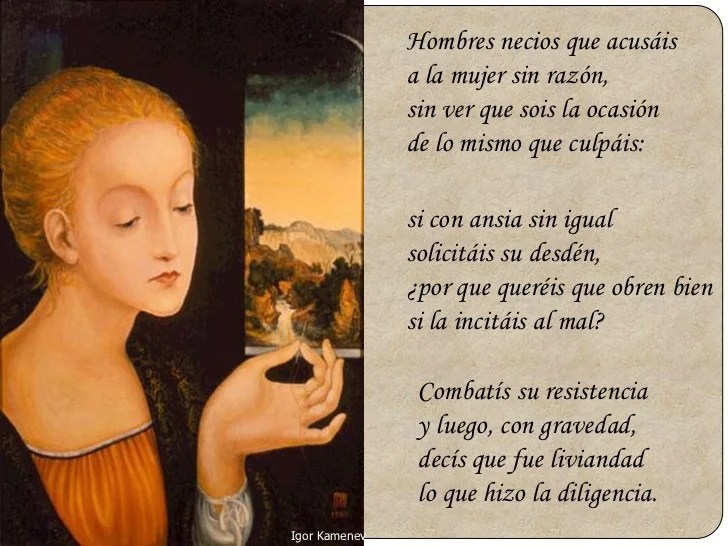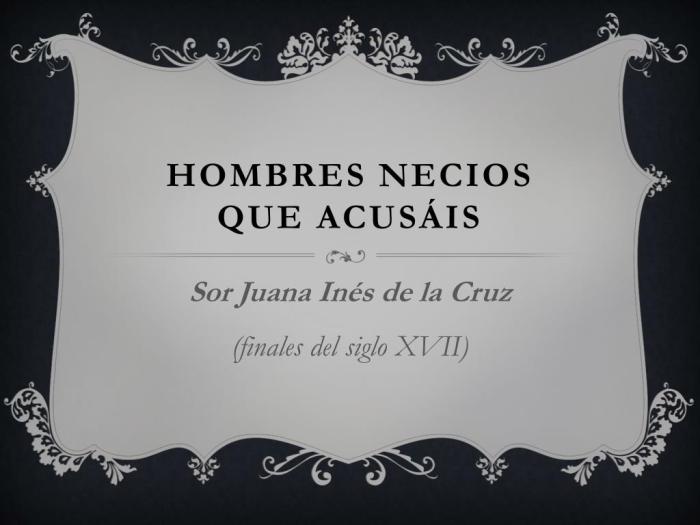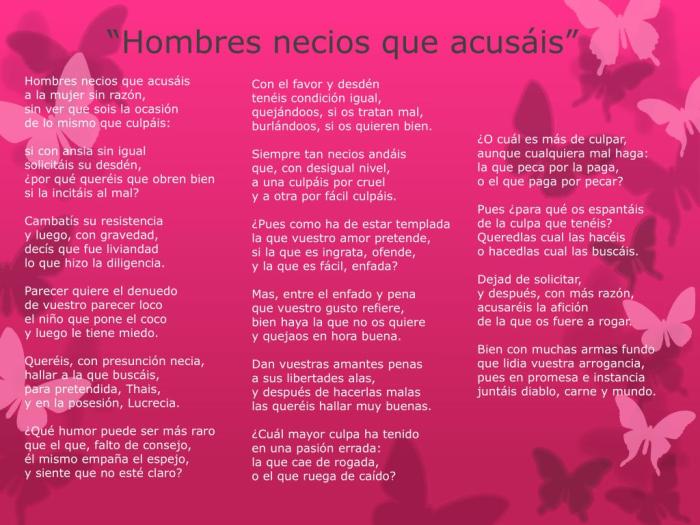In “Hombres Necios Que Acusáis Análisis,” we delve into the depths of a profound poem that confronts societal norms and the power of speech. This captivating work explores the intricate relationship between gender roles and the unjust accusations that women often face.
Through a comprehensive analysis of the poem’s structure, themes, and rhetorical devices, we unravel the author’s perspective and the enduring impact of this literary masterpiece.
Introduction to Hombres Necios Que Acusáis
Hombres Necios Que Acusáis, a renowned sonnet composed by the eminent Spanish poet Sor Juana Inés de la Cruz, stands as a timeless masterpiece that incisively critiques societal hypocrisy and double standards prevalent during the Baroque period.
Through its evocative imagery and thought-provoking verses, the poem delves into the paradoxical nature of human behavior, exposing the tendency to condemn others for actions that one engages in oneself. Sor Juana’s keen observations and astute insights into human nature have ensured the poem’s enduring relevance and significance.
Author’s Perspective
Sor Juana, a nun and renowned intellectual of her time, employs a first-person perspective in the poem, addressing a group of unnamed individuals referred to as “hombres necios” (foolish men). This direct address creates a sense of immediacy and intimacy, drawing the reader into the poet’s argument.
The poem’s central thesis revolves around the hypocrisy of those who criticize and condemn women for their supposed transgressions while indulging in the same behaviors themselves. Sor Juana’s incisive critique exposes the double standards and societal biases that unjustly targeted women during her era.
Main Themes
- Hypocrisy and Double Standards:The poem’s primary focus lies in exposing the hypocrisy of those who condemn others for actions they themselves commit. Sor Juana highlights the disparity between societal expectations for women and the reality of human nature.
- Gender Inequality:Hombres Necios Que Acusáis sheds light on the gender inequality prevalent in the Baroque period. Sor Juana challenges the patriarchal norms that limited women’s freedom and autonomy, advocating for their right to education and self-expression.
- Individuality and Authenticity:The poem encourages individuals to embrace their true selves and resist societal pressures to conform. Sor Juana argues that true worthiness lies in one’s actions and character, regardless of gender or societal expectations.
Analysis of the Poem’s Structure

The poem “Hombres necios que acusáis” by Sor Juana Inés de la Cruz exhibits a structured composition that reinforces its central themes and enhances its impact. The poem comprises four stanzas, each composed of eight lines. The rhyme scheme follows an ABBA ABBA pattern, contributing to a sense of rhythm and cohesion.
The meter is octosyllabic, with each line containing eight syllables, creating a consistent cadence.
Stanzas
The poem is divided into four distinct stanzas, each focusing on a specific aspect of the argument. The first stanza introduces the main theme of male hypocrisy and double standards, while the second stanza explores the ways in which women are unjustly criticized for their actions.
The third stanza shifts the focus to the speaker’s own experience and the challenges she faces as a woman seeking intellectual pursuits. The final stanza concludes the poem with a powerful assertion of the speaker’s worth and a condemnation of the societal norms that seek to suppress her.
Rhyme Scheme
The ABBA ABBA rhyme scheme creates a sense of predictability and order, which contrasts with the chaotic and unjust world the speaker describes. The regular rhyme pattern draws attention to the speaker’s logical and well-reasoned argument, emphasizing the validity of her claims.
It also adds a musical element to the poem, making it more engaging and memorable.
Meter
The octosyllabic meter contributes to the poem’s accessibility and appeal. The short lines and consistent rhythm make the poem easy to read and understand, allowing the speaker’s message to reach a wider audience. The octosyllabic meter also creates a sense of urgency and immediacy, reflecting the speaker’s passionate and assertive tone.
Thematic Analysis

At the heart of Sor Juana’s “Hombres necios que acusáis,” a profound critique of societal norms and gender roles unfolds. The poem explores the power dynamics between men and women, questioning the validity of accusations leveled against women while highlighting the hypocrisy and double standards that prevail.
Gender Roles and Societal Expectations
Sor Juana challenges the traditional gender roles that confine women to domestic and passive roles while allowing men to indulge in vices. She argues that women are equally capable of reason and virtue, yet they are subjected to unfair criticism and judgment.
“¿Con qué cara pretendéis/que el mundo enmendéis/vosotros, si sois tan malos?”
The poet questions the authority of men to condemn women’s behavior when they themselves engage in similar or worse transgressions.
The Power of Speech
Sor Juana emphasizes the power of speech and the importance of using it responsibly. She argues that men often use their words to silence and control women, while women are denied the same privilege.
“¿No ha de haber un espíritu/valiente que en vos reprehenda/vuestra maldad?”
The poet calls for a courageous voice to challenge the injustices faced by women and to hold men accountable for their actions.
Symbolism and Imagery
The poem “Hombres Necios Que Acusáis” employs a rich array of symbols and images to convey its message and evoke emotions. These elements contribute significantly to the poem’s depth and impact.
Symbolism of Nature
Nature plays a pivotal role in the poem, symbolizing the enduring and transformative power of the natural world. The “torrential storms” and “raging seas” represent the challenges and obstacles that the speaker encounters, while the “golden dawn” and “flowering fields” symbolize hope, renewal, and the possibility of a better future.
Imagery of Contrast
The poem juxtaposes contrasting images to highlight the conflict between the speaker’s ideals and the harsh realities of the world. The “noble steed” symbolizes the speaker’s aspirations and dreams, while the “muddy paths” represent the difficulties and obstacles that he faces.
This imagery creates a vivid and poignant depiction of the struggle between hope and despair.
Personification of Time
Time is personified as a “swift steed” that “gallops away,” representing the relentless and unforgiving nature of time. This imagery emphasizes the ephemeral nature of life and the importance of seizing opportunities while they are still available.
Imagery of Light and Darkness
The poem uses imagery of light and darkness to symbolize the contrast between truth and falsehood. The “bright light” represents the truth that the speaker seeks to convey, while the “dark shadows” represent the ignorance and deception that he encounters.
This imagery creates a vivid and evocative depiction of the struggle between good and evil.
Rhetorical Devices
The poem “Hombres Necios Que Acusáis” by Sor Juana Inés de la Cruz employs a range of rhetorical devices to enhance its impact and convey the author’s message. These devices include metaphors, similes, and personification, each contributing to the poem’s vivid imagery and persuasive tone.
Metaphors
Sor Juana uses metaphors to create powerful analogies that illuminate the poem’s central themes. For instance, she compares the foolish men who criticize women to “blossoms born in an unfortunate hour,” suggesting that their ignorance stems from a lack of enlightenment.
Similarly, she describes women as “fragile crystals” to emphasize their vulnerability and the need for their protection.
Similes
Similes are also employed to draw parallels between abstract concepts and concrete images. Sor Juana likens the foolish men’s accusations to “arrows shot in the dark,” highlighting the randomness and futility of their attacks. Moreover, she compares the women’s resilience to that of “oaks that endure the storms,” underscoring their strength and ability to withstand adversity.
Personification, Hombres necios que acusáis análisis
Personification is used to give human qualities to inanimate objects or abstract concepts. Sor Juana personifies “reason” as a “judge” who will ultimately condemn the foolish men for their ignorance. Additionally, she personifies “time” as a “thief” who steals away the beauty and youth of women, highlighting the ephemeral nature of physical appearance.
Comparison to Other Works

Hombres Necios Que Acusáis exhibits similarities and distinctions with other notable literary creations.
The poem shares affinities with the Renaissance sonnet tradition, particularly the Petrarchan sonnet form. Like many Petrarchan sonnets, Hombres Necios Que Acusáis comprises an octave (eight lines) followed by a sestet (six lines). The octave presents a problem or argument, while the sestet offers a resolution or commentary.
Relation to Literary Movements
Hombres Necios Que Acusáis also aligns with the broader literary movement of humanism, which emerged during the Renaissance. Humanism emphasized the importance of human reason and experience, as well as the study of classical literature and philosophy. Quevedo’s poem reflects these humanist ideals by critiquing the irrationality and ignorance of those who accuse women without cause.
Impact and Legacy: Hombres Necios Que Acusáis Análisis

Hombres Necios Que Acusáis has had a profound impact on literature and society since its publication. The poem’s powerful indictment of male hypocrisy and misogyny has resonated with readers for centuries.
The poem has been widely anthologized and studied in schools and universities. It has also been translated into many languages, reaching a global audience. The poem’s message of female empowerment and equality has inspired countless women and men to fight for social justice.
Interpretation and Use
Hombres Necios Que Acusáis has been interpreted and used in a variety of ways throughout history. Some have seen it as a feminist manifesto, while others have seen it as a more general critique of human nature.
The poem has been used to support a variety of causes, including women’s suffrage, equal rights, and reproductive rights. It has also been used to challenge traditional gender roles and stereotypes.
Frequently Asked Questions
What is the main theme of “Hombres Necios Que Acusáis”?
The poem explores the theme of gender roles and the unjust accusations that women often face.
How does the author use rhetorical devices in the poem?
The author employs rhetorical devices such as metaphors, similes, and personification to enhance the poem’s impact and convey its message.